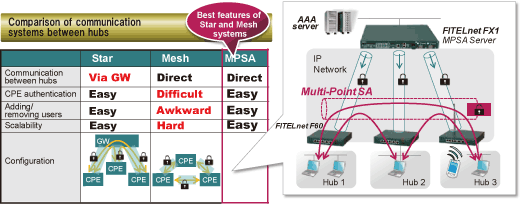FITELnet FX1 high performance, highly functional, ultra-slim multiservice router to go on sale
- World-leading technology condensed into a small box -
Furukawa Electric Co. Ltd. ("Furukawa Electric") is set to launch FITELnet FX1, a multiservice router designed to offer outstanding cost performance, at the end of August 2013. Based on technologies developed with G Series and FX Series products for telecommunications carriers, the new product combines functions such as MPLS(note 1)and IPsec(note 2) with high performance 30Gbps capabilities, and is equipped with 10 Gigabit Ethernet(note 3) ports, all within a slim 1U(note 4)size housing.
Building on proven, advanced technologies and expertise developed through Furukawa Electric's existing products, for telecommunications carriers' commercial networks and corporate user networks, FITELnet FX1 offers unrivalled levels of functionality and performance. With so many functions condensed into a small 1U box, it will also help to cut costs and improve quality, as well as saving both power and space. FITELnet FX1 supports an extensive range of software options and can be customized to suit any network, in terms of functionality and scale. It can therefore be used for a wide range of telecommunication purposes, from large-scale commercial networks to medium- or small-scale corporate networks.
Working with development engineers, Furukawa Electric has also set out a support system to harness its strengths as a domestic network equipment manufacturer, handling everything from design to manufacturing within Japan, and will be providing powerful backup to enable users to create high performance, highly functional networks.

Standard Price and Sales Target
Standard price (excluding tax) : From 8.4 million yen (projected)
Sales target : 500 units per year
Features of FITELnet FX1
- High performance and functionality condensed to 1U size
FITELnet FX1 offers advanced functionality and high 30Gbps throughput in a slim U1 size housing. - All ports equipped with gigabit Ethernet interfaces
FITELnet FX1 is equipped with 2x10 Gigabit Ethernet ports and 10x1 Gigabit Ethernet ports. Each gigabit Ethernet port gives users the option of using metal cables (10/100/1000Base-T) instead of fiber optics. - Support for IP-VPN functionality
FITELnet FX1 offers high-scale compatibility with MPLS IP-VPN functionality, for use with carrier services. Each router has enough capacity for 4,000 corporate user networks. - High performance and functionality thanks to IPsec
FITELnet FX1 has high performance IPsec capabilities, in excess of 20,000 sessions and 14Gbps. It also supports IP-VPN Edge and IPsec data link functionality, as well as IPsec-HA(note 5), making IPsec instant switching possible, and MPSA (multi-point security association) center capabilities. - Support for L2GW (gateway) functionality
FITELnet FX1 supports L2GW functionality, in response to growing demand for L2 capacity (for Wi-Fi hotspots, etc.) Making the most of Furukawa Electric's carrier-class IPsec GW technologies and expertise, it also enables users to establish large-scale, stable L2 tunnel networks. - Extensive support for QoS functionality
FITELnet FX1 supports a wide range of QoS(note 6) capabilities, including policing, layer shaping and priority control for control packets addressed to the device. It also enables QoS functionality equivalent to L3 via L2 relay. - Equipped with MPSA (multi-point security association) functionality
FITELnet FX1 supports MPSA, a draft of which has been submitted to the standardization organization IETF (Internet Engineering Task Force). MPSA is an entirely new IPsec extension system, designed to resolve issues related to/on/with large-scale IPsec networks, including complexity, scalability and delays. It is based on the concept of software defined networking (SDN), meaning that all data required for communication between hubs is controlled by the MPSA server. As there is no need to reconfigure existing hubs when adding or removing CPE, users can set up automatically encrypted communication channels between hubs.
MSPA functions will be/are available by combining them with FITELnet F60/F200 as CPE.
MPSA (multi-point security association) System
- Hybrid system combining the best features from the Mesh and Star systems, enabling IPsec communication directly between hubs with minimal configuration
- Encrypted communication using a common key for all hubs, assigned by the MPSA server along with channels for each individual hub
- No need to configure CPE when adding or removing hubs

Notes
This product will be showcased in the exhibition area at JANOG32 in Osaka, running for two days on July 4 and 5, 2013. For further details, please ask a member of staff at the exhibition venue.
Glossary
(note 1)MPLS (Multi Protocol Label Switching)
MPLS is one method of creating a virtual private network (VPN). Packets are assigned identifiers called “labels” to enable high-speed forwarding. MPLS is commonly used in backbone networks for IP-VPN services.
(note 2)IPsec (IP security)
IPsec is a method of creating a virtual private network (VPN). “Packets” of data being forwarded are encrypted, tunneled and decoded, to prevent data from being altered or intercepted en route. This makes it possible to create a secured VPN.
(note 3)10 Gigabit Ethernet
10 Gigabit Ethernet is an Ethernet standard for communication at a speed of 10 gigabits per second (Gbps). It is compatible with previous Ethernet standards, and can help minimize installation and maintenance costs compared to other systems.
(note 4)1U
1U is the size of one unit in a 19-inch rack (approx. 44.5mm high). It is a standard unit determined by the Electronic Industries Alliance (EIA) in the United States.
(note 5)IPsec-HA
IPsec-HA is a technology that enhances the consistency of IPsec connections even in the event of hardware failure, by sharing IPsec control information between devices when duplicating components (e.g. virtual router redundancy protocol (VRRP)).
(note 6)QoS (Quality of Service)
QoS refers to the quality of service transmission, including band frequency, data transmission priorities and transmission delays. It is used in networks as a means of reserving band frequencies for specific communication and guaranteeing certain communication speeds.







 Share
Share Tweet
Tweet Share
Share